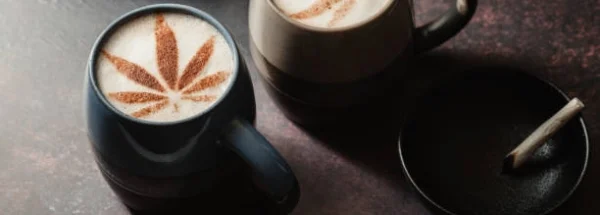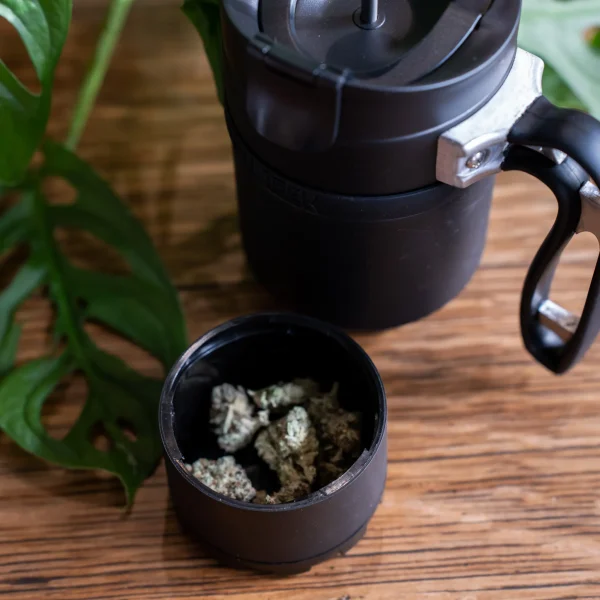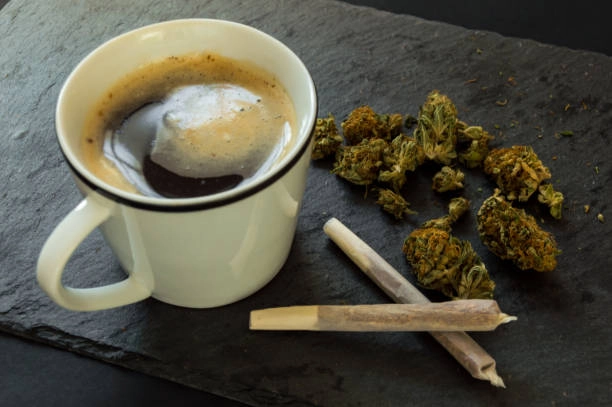Wake and bake, the practice of consuming cannabis and coffee together, has been a popular ritual among cannabis enthusiasts for decades. This combination of the energizing effects of caffeine and the relaxing effects of cannabis can provide a unique and enjoyable experience that can help start your day in a good mood. Whether you’re a seasoned cannabis user or new to the world of cannabis, wake and bake is an easy and accessible way to enjoy the benefits of both cannabis and coffee. In this blog post, we’ll take a closer look at the benefits, history, science, and best practices of wake and bake.
The Benefits of Coffee and Cannabis
One of the main benefits of combining cannabis and coffee is the enhanced focus and creativity that many users report. The caffeine in coffee can help to counteract some of the drowsiness that can be associated with cannabis use, making it an ideal choice for those who want to stay productive and alert. Additionally, the combination of the two can lead to a more balanced and enjoyable high, with the uplifting effects of caffeine complementing the relaxing effects of cannabis.
Another benefit of combining cannabis and coffee is the potential for increased health benefits. Studies have shown that cannabis may have anti-inflammatory and antioxidant properties, while coffee has been linked to a reduced risk of several diseases, including heart disease and type 2 diabetes.
The History of Coffee and Cannabis
Cannabis and coffee are two of the most widely consumed substances in the world, and their use has a rich and fascinating history that spans centuries and cultures. While the origins of cannabis use can be traced back to ancient China, coffee has its roots in Ethiopia. Both substances have been used for medicinal, ceremonial and recreational purposes throughout the ages.
The use of cannabis dates back to around 2737 BC, when the Chinese Emperor Shen Nung is said to have discovered the medicinal properties of the plant. From there, it spread to other parts of Asia, and eventually to Africa and the Middle East. In ancient Egypt, cannabis was used for a variety of medicinal purposes, including as a pain reliever and anesthetic. Similarly, in ancient India, cannabis was used as a medicine, as well as a sacrament in religious ceremonies.
Coffee, on the other hand, is believed to have originated in the highlands of Ethiopia. The legend goes that a goatherd named Kaldi noticed that his goats became unusually energetic after eating the berries of a certain plant. He tried the berries himself and found that they had a similar effect on him. He shared his discovery with the local monks, who began to cultivate the plant, and thus coffee was born. It was then spread to the Middle East and eventually to Europe and the Americas.
Throughout history, both cannabis and coffee have been used for medicinal purposes. Both were used as pain relievers, and coffee was also used to treat various ailments such as headaches, asthma, and even impotence. In the 19th century, both substances were used in patent medicines, which were over-the-counter drugs that were widely available and used to treat various ailments.
The recreational use of cannabis and coffee also has a long history. In the Middle East, coffee houses were popular gathering places where people would gather to drink coffee and engage in conversation. Similarly, in many parts of the world, cannabis has been used for social and recreational purposes.
The combination of cannabis and coffee, however, has a more recent history. While the use of cannabis and coffee separately has been well-documented throughout history, it wasn’t until the 20th century that the combination of the two became more common. The counterculture movement of the 1960s and 1970s saw an increase in the use of cannabis and coffee together, as people began to experiment with new ways of using the two substances.
Another benefit of combining cannabis and coffee is the potential for increased health benefits. Studies have shown that cannabis may have anti-inflammatory and antioxidant properties, while coffee has been linked to a reduced risk of several diseases, including heart disease and type 2 diabetes.
The Science of Consuming Coffee and Cannabis
Let’s dive deeper into the science behind the combination of cannabis and coffee and explore the potential benefits and risks of using these two substances together.
First, let’s take a look at how cannabis and coffee interact with the body. Cannabis contains a variety of compounds, the most well-known of which is tetrahydrocannabinol (THC), the primary psychoactive compound in cannabis. When consumed, THC binds to receptors in the brain, known as cannabinoid receptors, leading to changes in mood, perception, and other cognitive processes. Specifically, THC binds to CB1 receptors, which are primarily located in the brain and central nervous system. This binding leads to the release of dopamine, a neurotransmitter associated with pleasure and reward, and the inhibition of the release of glutamate, a neurotransmitter associated with excitatory signals in the brain. This leads to the well-known effects of cannabis such as relaxation, euphoria, and increased appetite.
Coffee, on the other hand, contains caffeine, a stimulant that blocks the action of a neurotransmitter called adenosine. Adenosine levels in the brain increase as the day goes on, making us feel sleepy. Caffeine blocks adenosine receptors, which in turn increases the activity of other neurotransmitters, such as dopamine and norepinephrine. This leads to increased alertness, concentration, and energy. Caffeine also increases the release of acetylcholine, a neurotransmitter associated with memory and learning, and decreases the release of GABA, a neurotransmitter associated with inhibition and relaxation.
When cannabis and coffee are consumed together, they can interact in a number of ways. They can produce a bit of an “entourage effect” by counteracting some of the adverse side effects of the other. Studies have shown that caffeine can enhance the cognitive effects of THC, such as attention and memory, and that THC can enhance the subjective effects of caffeine, such as enjoyment and sociability.
However, it’s important to note that the effects of using coffee and cannabis together can vary greatly depending on the individual, so it’s always a good idea to start with a small amount and work your way up, as well as to use a low THC strain to avoid feeling overwhelmed. Additionally, it’s important to note that excessive consumption of either substance can lead to negative side effects such as anxiety, paranoia, and insomnia. It’s also important to consider any potential interactions with any medications you may be taking.
The combination of cannabis and coffee can offer a unique and enjoyable experience, as well as potential benefits such as enhanced focus and creativity. However, it’s important to understand the science behind the combination and to use these substances responsibly.
The use of cannabis dates back to around 2737 BC, when the Chinese Emperor Shen Nung is said to have discovered the medicinal properties of the plant. From there, it spread to other parts of Asia, and eventually to Africa and the Middle East. In ancient Egypt, cannabis was used for a variety of medicinal purposes, including as a pain reliever and anesthetic. Similarly, in ancient India, cannabis was used as a medicine, as well as a sacrament in religious ceremonies.
Coffee, on the other hand, is believed to have originated in the highlands of Ethiopia. The legend goes that a goatherd named Kaldi noticed that his goats became unusually energetic after eating the berries of a certain plant. He tried the berries himself and found that they had a similar effect on him. He shared his discovery with the local monks, who began to cultivate the plant, and thus coffee was born. It then spread to the Middle East and eventually to Europe and the Americas.
Throughout history, both cannabis and coffee have been used for medicinal purposes. Both were used as pain relievers, and coffee was also used to treat various ailments such as headaches, asthma, and even impotence. In the 19th century, both substances were used in patent medicines, which were over-the-counter drugs that were widely available and used to treat various ailments.
The recreational use of cannabis and coffee also has a long history. In the Middle East, coffee houses were popular gathering places where people would gather to drink coffee and engage in conversation. Similarly, in many parts of the world, cannabis has been used for social and recreational purposes.
The combination of cannabis and coffee, however, has a more recent history. While the use of cannabis and coffee separately has been well-documented throughout history, it wasn’t until the 20th century that the combination of the two became more common. The counterculture movement of the 1960s and 1970s saw an increase in the use of cannabis and coffee together, as people began to experiment with new ways of using the two substances.
Another benefit of combining cannabis and coffee is the potential for increased health benefits. Studies have shown that cannabis may have anti-inflammatory and antioxidant properties, while coffee has been linked to a reduced risk of several diseases, including heart disease and type 2 diabetes.

The Dosage and Timing of Cannabis and Coffee: How to Get the Perfect Balance
Finding the perfect balance of dosage and timing can be a delicate process. Let’s take a deep dive into getting it just right with cannabis and coffee.
First, let’s talk about dosage. The recommended dosage for cannabis can vary depending on a number of factors, including the individual’s tolerance, the method of consumption, and the specific strain being used. It’s important to start with a low dosage, anywhere from 2.5-5mg of THC, and gradually increase it until you find the right amount for you. When using cannabis and coffee together, it’s especially important to start low, as the combination can enhance the effects of both substances. It’s also worth noting that different methods of consumption will have varying onset and duration of effects, for example, smoking or vaporizing will have a faster onset compared to edibles, but the effects will last longer.
Timing is also a crucial factor to consider when using cannabis and coffee together. The effects of caffeine can take anywhere from 15 minutes to an hour to kick in and can last up to six hours, while the effects of cannabis can take anywhere from 30 minutes to two hours and can last up to 8 hours depending on the method of consumption. It’s important to find the right timing that works for you and that allows you to enjoy the effects of both substances without one overpowering the other. A general rule of thumb is to wait at least an hour after consuming cannabis before having coffee, this will allow you to gauge the effects of cannabis before adding the stimulating effects of caffeine.
Cannabis and Coffee Pairing: How to Match Strains and Roasts for the Perfect Flavor Profile
When it comes to “wake and bake”, the combination of cannabis and coffee, it’s not just about the effects but also the flavor. Just like wine and food pairing, cannabis and coffee pairing can be an art form, and the right combination can enhance the overall experience. In this blog post, we’ll take a closer look at how to match different strains of cannabis and different roasts of coffee to create the perfect flavor profile.
First, let’s take a look at cannabis strains. Different strains of cannabis have different flavor profiles, and some strains are better suited for certain flavor profiles than others. For example, strains with a high concentration of the terpene limonene, such as Super Lemon Haze, have a strong citrus flavor and can be paired with a light roast coffee for a refreshing and citrusy experience. On the other hand, strains with a high concentration of the terpene myrcene, such as Blue Dream, have a sweet and earthy flavor and can be paired with a medium roast coffee for a smooth and balanced experience.
When it comes to coffee roasts, different roasts have different flavor profiles as well. Light roasts have a lighter body and acidity, and are known for their bright and fruity flavors. They can be paired with strains that have a fruity or citrusy flavor profile for a refreshing and lively experience. Medium roasts have a balanced acidity and body, and are known for their chocolate and nutty flavors. They can be paired with strains that have a sweet or earthy flavor profile for a smooth and balanced experience. Dark roasts have a heavy body and low acidity, and are known for their bold and smoky flavors. They can be paired with strains that have a spicy or pungent flavor profile for a rich and intense experience.
When pairing cannabis and coffee, it’s important to take into consideration the different flavor profiles of both the strain and roast. While personal preference plays a role, experimenting with different pairings can lead to new and exciting flavor combinations. It’s also important to note that the effects of cannabis can also enhance or alter the taste of coffee. The psychoactive effects of THC can enhance the sweetness, and the non-psychoactive effects of CBD can add a nutty or earthy taste to the coffee. This can further enhance the flavor profile of the coffee and make the pairing more enjoyable.
When experimenting with different cannabis and coffee pairings, it’s best to start with small amounts and work your way up. It’s also important to consider any potential interactions with any medications you may be taking and always comply with your local laws.
Cannabis and coffee pairing can be an art form, and the right combination can enhance the overall experience. By understanding the different flavor profiles of both the strain and roast, and experimenting with different pairings, you can create the perfect flavor profile for your wake and bake ritual.
Cannabis and Coffee Pairing: How to Match Strains and Roasts for the Perfect Flavor Profile
When it comes to pairing cannabis and coffee, the flavor profile is just as important as the effects. Terpenes are a class of organic compounds found in plants, including cannabis and coffee, that are responsible for their distinct aroma and flavor. They are found in the essential oils of plants and are responsible for the different scents we associate with different strains of cannabis and different roasts of coffee.
Cannabis strains contain a variety of terpenes, each with their own unique aroma and flavor profile. Some common terpenes found in cannabis include limonene, which has a citrusy aroma and flavor, and myrcene, which has a musky and earthy aroma and flavor. When it comes to coffee, different roasts also have different terpene profiles. For example, light roasts tend to have higher levels of terpenes like citronellol, which has a floral aroma, while dark roasts tend to have higher levels of terpenes like guaiacol, which has a smoky aroma.
When pairing cannabis and coffee, it’s important to consider the terpene profiles of both the strain and roast. For example, pairing a strain high in limonene with a light roast coffee can enhance the citrusy flavor and create a refreshing and lively experience. On the other hand, pairing a strain high in myrcene with a dark roast coffee can enhance the musky and earthy flavor and create a smooth and balanced experience.
It’s worth noting that terpenes not only impact the flavor profile but also have therapeutic benefits. For example, Limonene is known to have anxiolytic properties and can help to reduce stress and anxiety, Myrcene is known to have sedative properties and can help to promote relaxation and sleep. Therefore, considering terpenes can be beneficial not just for the taste but also for the therapeutic benefits.
Check out our product, The Bru N’ Bake, to enjoy coffee and cannabis together. It’s a french press that brews 16 fl. oz. and has a secret storage container on the bottom to store and keep your flower fresh.




